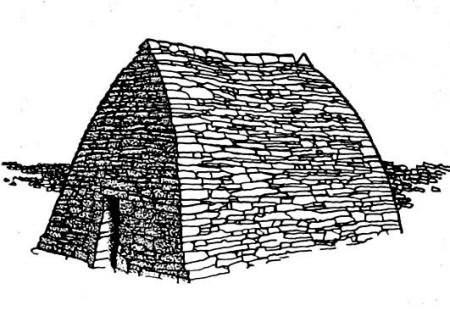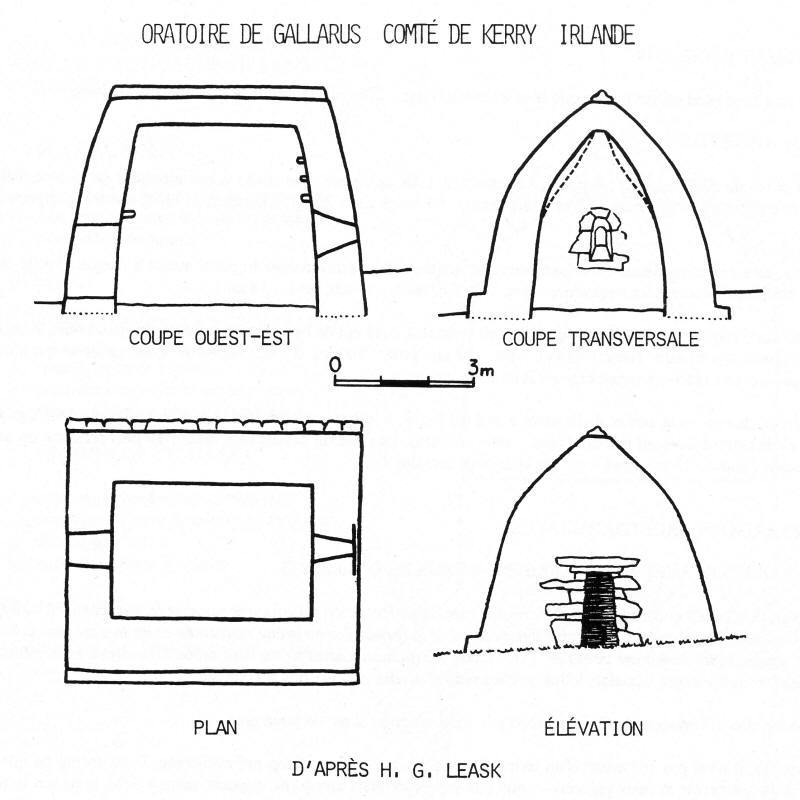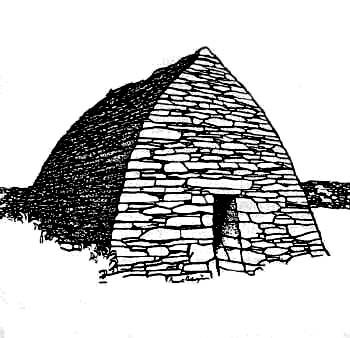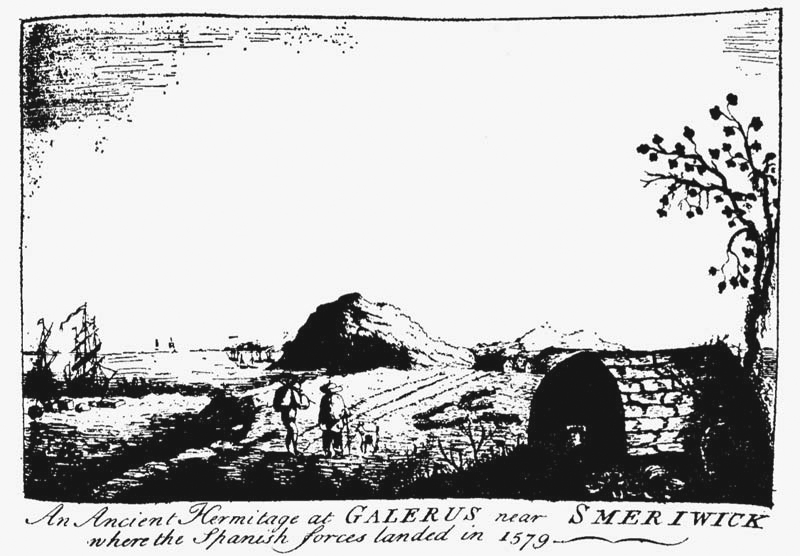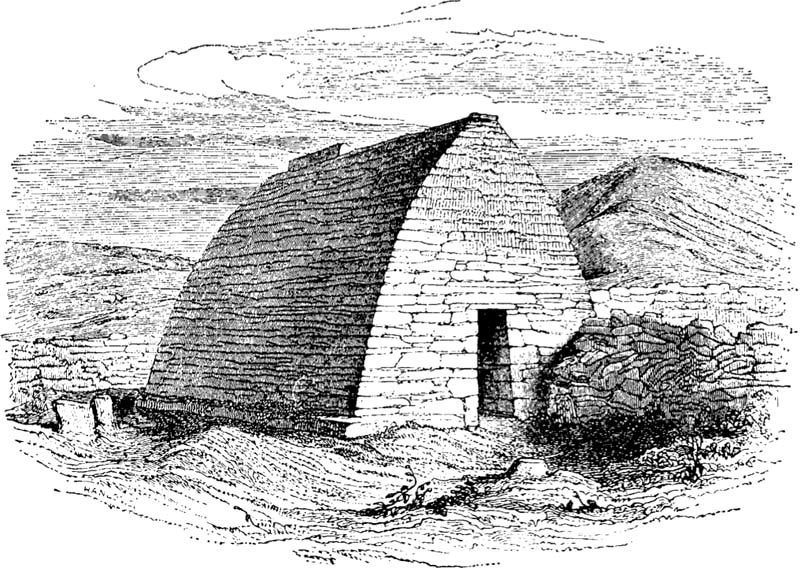|
IS THE GALLARUS "ORATORY" IN COUNTY KERRY, IRELAND, Christian Lassure First published in the French journal L'Architecture vernaculaire, tome XVIII, 1994, p. 45-47
When Françoise Henry, in a 1957 article about the so-called monastic site on Skellig Michael island (1), chose to refer to the local edifices with the shape of an upturned boat as "oratories," she had in mind, like her predecessors, the famous Gallarus "oratory" on the Dingle peninsula, a structure that specialists of Irish art envisioned at the time as the earliest specimen of stone church, dating it variously to the 6th, the 8th, or the 7th century to split the difference. In other words, the Skellig Michael "oratories" are called "oratories" because they bear a morphological resemblance to the Gallarus "oratory."
Alas, in 1980, the myth of the earliest stone church in Ireland was given a pounding by archaelogist Peter Harbison (2). After finding that there existed no written or archaeological evidence to vindicate so early a date, he placed the construction of the oratory as late as the 12th century on the strength of a number of stylistic features (the flat lintel over the entrance, the small window with rounded arch in the East end wall, a carved finial).
To this writer, it seems that even a 12th-century date is still too early and Peter Harbison may have been overly timid in his questioning the unfounded claims of his predecessors. Indeed, Harbison produces some evidence pointing to a later date and a different use : a letter by one Richard Pococke who visited the "oratory" in 1758, two years after it was "discovered" by Charles Smith (also the "discoverer" of Skellig Michael monastic stone huts) : "Near this building they show a grave with a head at the cross of it and call it the tomb of the Giant; the tradition is that Griffith More was buried there, & as they call'd [it] a chapel, so probably it was built by him or his family at their burial place" (p. 36).
It is obviously regrettable that Peter Harbison did not see it fit to take into account such an invaluable testimony ("Pococke [...] we may dismiss," he says on page 43) which mentions the oral tradition locally extant in 1758. "I have been unable to find out anything about Griffith More," he writes in a footnote on page 36. He certainly could have surmised that the latter was likely to be a late 17th-century or early 18th-century local landlord or official (5) with the wherewithal to have a private funerary chapel built for himself and his family.
In the light of the building's possible funerary use and rather late date, it is not difficult to understand why "minor trial cuttings carried out by T. Fanning at Gallarus in November 1970, on behalf of the National Monuments Branch of the Office of Public Works, [...] yielded no finds or evidence of features or activity which might shed light on the period of construction and use of the oratory," as Peter Harbison truthfully admits (pp. 57-58).
It is not difficult either to understand why the walling is so homogeneous and no alterations are visible in the structure's plan and form: far from being a multisecular affair with a long history, the edifice must have originated in a period that is much closer to the time of its "discovery" by Charles Smith in 1756
If the Gallarus "oratory" is actually nothing more than a 17th-century private funerary chapel, then its architecture and morphology are cast under a new light. With a doorway with a flat lintel in the West wall and a round-headed window in the East wall for its sole openings, the edifice is in keeping with the traditional stereotype of the cemetery chapel. With the building of a sturdy, indeformable and long-lasting structure in mind, the architect adopted a number of unique yet efficient technical solutions:
- two side walls and two end walls, sloping and converging at the top, each of one piece, playing a dual role of load-bearer and corbelled vault – an ingenious solution which denotes full mastery of corbelling in stone roofs (6);
- cutting of stones on every side and end so that they fit perfectly together and exhibit smoothly finished facings that follow the slant of the wall, a solution which is reminiscent of dry stone walling with its striving for perfect fit while at the same time diverging from it with its systematic use of dressed stones;
- use of a thin layer of lime mortar to bond stones together and to fill in small hollows in the inner faces (7).
It is easy to imagine that those technical choices must have been very expensive for the builder because of the sheer volume of stones to quarry and ferry to the site (8) and the large amount of labour required for the cutting and assembling of stones. The result is there for everybody to see: an edifice of impressive robustness, remarkable aesthetic appeal and with an undeniable archaic touch. One finds oneself regretting that no trace of Griffith More, the supposed sponsor, has been available. Unquestionably, some further research is in order.
However, one must not delude oneself. Even if Griffith More's identity were revealed, the myth is so overpowering and ubiquitous that even a refutation in a peer-reviewed journal would prove unable to quash it. The hoax-like myth created by Charles Smith in 1756 has run its course and is now prevalent in scholarly and touristic literature as well as in the field itself. An 8th-century or at the very latest 12th-century oratory is bound to have more appeal to visitors than a 17th-century family funerary chapel, however quaint.
NOTES
(1) Françoise Henry, Early Monasteries, Beehive Huts, and Dry-stone Houses in the Neighbourhood of Caherciveen and Waterville (Co. Kerry), in Proceedings of the Royal Irish Academy, vol. LVIII, No 3, February 1957, pp. 45-166, specially pp. 121-126.
(2) See Peter Harbison, How old is Gallarus oratory? A reappraisal of its role in early Irish architecture, in Medieval Archeology, vol. XIV, 1970, pp. 34-59.
(3) See P. O'Maidin, "Pococke's tour of south and south-west Ireland in 1758", in Journal of the Cork Historical and Archaeological Society, vol. LXIV, 1959, specially letter No 14.
(4) Charles Smith, The Antient and Present State of the County of Kerry, Dublin, 1756, pp. 113 and following.
(5) On the credibility of oral tradition, see our article, Faut-il accorder encore quelque crédit à ce qu'il est convenu d'appeler "la tradition orale", in L'Architecture vernaculaire, t. 16, 1992, pp. 3-4.
(6) On roofings that look like upturned boats and consist of two opposite corbelled side walls and two opposite corbelled end walls, see our article "Les Cabanes" à Gordes (Vaucluse) : architecture et édification, in L'Architecture vernaculaire rurale, supplément No 2, 1980, pp. 143-160. "La forme en carène renversée se rencontre sur des plans de base allongés (rectangle, trapèze rectangle). Elle repose sur le principe de deux longs murs (ou goutterots) rectilignes (..). qui sont symétriquement opposés par rapport à un axe médian de façon que la distance entre leurs bases respectives soit au moins égale à deux fois l'encorbellement maximal possible; entre les sommets des parois opposées, est laissé un vide de 50 à 70 cm que viennent couvrir une série de dalles jointives (...) formant plafond. Le même principe est adopté pour les petits côtés (ou pignons), formés eux aussi par deux encorbellements symétriques opposés. Ces quatre éléments opposés deux à deux se contrebutent mutuellement aux angles, renforçant ainsi la stabilité de l'ensemble. Ce type de structure mérite à juste titre le nom de voûte par encorbellements (au pluriel). Le traitement de la crête de l'édifice varie selon les cas : les dalles de couvrement peuvent être chargées (...) de plusieurs épaisseurs de pierres plates et d'une dernière assises de grandes dalles donnant un faîtage plat (...); ou bien, au contraire, les dalles de couvrement sont chargées de plusieurs épaisseurs décroissantes de pierres donnant à la crête un angle aigu. Au plan de la morphologie, la structure en carène peut se définir comme deux grands trapèzes isocèles, aux côtés convexes et à la face courbe, réunis à angle droit à leurs extrémités par deux petits triangles isocèles aux côtés convexes et à la face courbe. La courbe des faces extérieures des édifices a un profil qui varie, selon la plus ou moins grande hauteur de ceux-ci, entre une courbure convexe régulière tendant vers la verticale et une ligne quasi-brisée" (p. 148).
(7) These features are mentioned by H. G. Leask in Irish Churches and Monastic Buildings, vol. I, Dundalk, 1955, p. 22. This is repeated by Harbison, who also cites Dunraven's finding (in Notes on Irish Architecture, I, M. Stokes, 1875) of a "hard white stuff between the joints."
(8) Charles Smith, op. cit., p. 191, writes that the stone is "a brown free-stone, brought from the cliffs of the sea shore, which cuts readily, and is very durable."
© CERAV
To be referenced as : Christian Lassure
home page The dry stone huts of Skellig Michael myths
|

